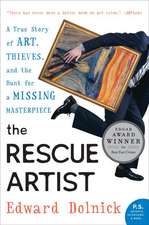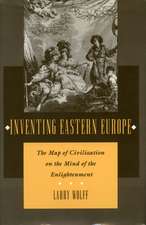The Singing Turk: Ottoman Power and Operatic Emotions on the European Stage from the Siege of Vienna to the Age of Napoleon
Autor Larry Wolffen Limba Engleză Hardback – 30 aug 2016
After Christian armies defeated the Ottomans at Vienna in 1683, the Turks no longer seemed as threatening. Europeans increasingly understood that Turkish issues were also European issues, and the political absolutism of the sultan in Istanbul was relevant for thinking about politics in Europe, from the reign of Louis XIV to the age of Napoleon. While Christian European composers and publics recognized that Muslim Turks were, to some degree, different from themselves, this difference was sometimes seen as a matter of exotic costume and setting. The singing Turks of the stage expressed strong political perspectives and human emotions that European audiences could recognize as their own.
Preț: 785.64 lei
Preț vechi: 1020.32 lei
-23% Nou
150.35€ • 156.39$ • 124.12£
Carte tipărită la comandă
Livrare economică 14-28 aprilie
Specificații
ISBN-10: 0804795770
Pagini: 504
Dimensiuni: 152 x 229 x 33 mm
Greutate: 0.79 kg
Editura: Stanford University Press
Colecția Stanford University Press
Recenzii
Notă biografică
Cuprins
The introduction sets the problem of operatic representation in the context of the Triplex Confinium, the adjacency of the Ottoman, Venetian, and Habsburg states in the eighteenth century, creating circumstances of war and hostility, but also coexistence and familiarity. Venice and Vienna were significant both as capitals of the Triplex Confinium and as operatic centers for works on Turkish themes. Some familiarity and fascination with elements of Turkish musical style¿ Janissary or alla turca style¿ was one aspect of this geopolitical situation, and the introduction makes the case for thinking about musical issues in the context of international relations and the dynamics of war and peace. Finally, the introduction considers how the singing Turk on the operatic stage addressed issues of European identity in the age of Enlightenment, in matters of political theory, emotional discipline, and the presumption of civilization.
This chapter suggests that, following the failed Ottoman siege of Vienna in 1683, a lessening of fear and anxiety in Europe coincided with the emergence of operas about Turks as European entertainment¿even as Ottoman territorial recession was articulated in the treaties of Karlowitz (1699) and Passarowitz (1718). The most important subject of such operas, initially, was Tamerlane's capture of Sultan Bajazet, with the sultan singing in captivity as the emblem of Ottoman defeat, engaging European sympathy rather than dread. Such operas appeared first in Venice and Hamburg in 1689 and 1690, and then found definitive form with the libretto by Agostino Piovene and music by Francesco Gasparini in Venice in 1711, revised for Reggio Emilia in 1719. The most celebrated such work was Handel's Tamerlano, in London in 1724, borrowing Gasparini's tenor Francesco Borosini for the role of Bajazet. Vivaldi also set the Piovene libretto as Bajazet in 1735.
This chapter considers Paris as an operatic perspective on the Ottoman empire, conditioned both by the relative remoteness of Paris from Istanbul and the longterm French solidarity with the Ottomans against the Habsburgs. The Paris fairs of the early eighteenth century served as a matrix for the emergence of new musical comedies on Turkish themes, including the comical figure of Arlequin (Harlequin). The Ottoman embassy to Paris in 1720-1721 stimulated a fashionable cultural interest in Turquerie, while the publication of Montesquieu's Persian Letters in 1721 as a foundational work of the French Enlightenment encouraged a philosophical perspective on the Muslim world. These new attitudes received their most important and influential operatic expression in Rameau's Les Indes galantes of 1735, with one act titled Le Turc généreux. The "generous Turk" was a magnanimous and sympathetic pasha who ultimately emancipated a female European captive from his harem.
This chapter presents the French musical comedy phenomenon of Charles-Simon Favart's The Three Sultanas (Les Trois Sultanes) of 1761, about Sultan Suleiman the Magnificent and the favorite of his harem, Roxelana, as performed by Marie-Justine Favart. In this Parisian work the Ottoman sultan was triumphantly "civilized" by Roxelana, who was fictively imagined as a Frenchwoman in Suleiman's harem. The work was staged and costumed in the spirit of cultural Turquerie, and was politically meaningful in relation to the court of Louis XV and the influence and precedence of his mistress Madame Pompadour. There was also a roughly concurrent opera seria libretto concerning Suleiman, titled Solimano, and first composed by Johann Adolph Hasse for Dresden in 1753. Favart's Three Sultanas was translated, recomposed, and restaged all over Europe, including notable versions composed by Joseph Martin Kraus for Stockholm in 1789, and by Franz Xaver Süssmayr for Vienna in 1799.
This chapter focuses on the 1760s and 1770s, especially in the Habsburg monarchy, as Gluck and Haydn began to compose comic operas on Turkish themes making use of Janissary percussion and alla turca style. Cultural interest in the Ottomans was conditioned by the presence of Ottoman envoys in Vienna in the age of Maria Theresa and, especially, by the international circumstances of the Russian-Turkish war of 1768 to 1774. Gluck's and Haydn's French and Italian versions of the same subject, Les Pèlerins de la Mecque and L'incontro improvviso, are discussed with reference to the comical figure of the Kalender. Haydn's comic opera Lo speziale, performed at Esterháza in 1768, is considered in relation to operatic Turkish travesty and disguise. The news of the ongoing war between the Turks and Russians created a climate encouraging for comic operas about Turks, including works by Niccolò Jommelli and Georg Joseph Vogler.
This chapter discusses the creation of Mozart's Abduction from the Seraglio in 1781 and 1782 in the context of the approaching centennial of the Ottoman siege of Vienna in 1783. Mozart turned from a serious Turkish subject in the unfinished opera Zaide to a comic Turkish subject in the Abduction, using alla turca musical style. In the Abduction the issue of Osmin's rage, his inability to master his emotions, was also relevant to Mozart's own recent conditions of service under Archbishop Colloredo in Salzburg. Singing in the deepest part of the basso range, Ludwig Fischer in the role of Osmin offered a representation of Turkish masculinity that removed all suspicion that Osmin, as overseer of the sultan's harem, might actually be a eunuch. In fact, eighteenth-century culture kept carefully distinct the dangerously related discourses concerning harem eunuchs, on the one hand, and operatic castrati, on the other.
This chapter considers the political and emotional dynamics of Mozart's Sultan Soliman in Zaide, and then addresses the dramatic portrait of Pasha Selim in the Abduction as a very purposeful effort by the composer to bring himself to the attention of Habsburg Emperor Joseph II. Pasha Selim was made to appear as a model of Ottoman magnanimity which was intended to reflect upon the emperor in the audience at the first performance in 1782. The course of Josephine enlightened absolutism was closely correlated with Mozart's career in Vienna, and Mozart showed himself a dedicated Josephine with his musical attentions to Joseph's Turkish war of 1787. This chapter also considers the enormous and persistent success of Grétry's La Caravane du Caire as a French counterpart to the Abduction in the 1780s, with parallel political implications. The Ottoman accession of Sultan Selim III is discussed in relation to European enlightened absolutism.
This chapter considers Napoleonic Europe as the context for the formation of the young Rossini as an opera composer, with particular attention to Napoleon's invasion of Ottoman Egypt, which coincided with the first Parisian production of Mozart's Abduction in 1798. There were new attentions to Ottoman themes in Napoleonic Paris during the first decade of the century, not only at the Paris Opéra, but also in musical comedies and burlesque satires. In 1812 Rossini brought his own brand of Turkishness to La Scala in Napoleonic Milan with La pietra del paragone and its immensely popular comical scene of Turkish disguise. Stendhal, as an ardent admirer of Rossini, hailed the composer as Napoleon's successor, making his very own musical conquest of Europe.
This chapter focuses on Rossini's L'Italiana in Algeri, considered as a Venetian triumph for Rossini in 1813, employing Turkish themes that resonated with Venetian-Ottoman history. The libretto by Angelo Anelli had been composed earlier by Luigi Mosca. Rossini's opera is considered in the context of Mediterranean piracy and captivity, and interpreted as an opera of conquest in which the heroine Isabella executes a successful European campaign against the Algerian Mustafa Bey¿ in some sense anticipating the French invasion of Algeria in 1830. The farce of reciprocal Ottoman-European honors¿ Pappataci and Kaimakan¿ is shown to reflect not the unbridgeable differences but rather the Mediterranean resemblances between the Napoleonic Italians and the Ottoman Algerians. Isabella's famous aria "Pensa alla patria" presented Italian patriotism within an Ottoman scenario. The basso Filippo Galli sang the role of Mustafa Bey, as he sang all of Rossini's leading Turkish roles.
This chapter focuses on the Romantic conception of the singing Turk in Rossini's Il Turco in Italia. After centuries of European warfare with the Ottomans, Rossini in 1814, working with the librettist Felice Romani, conjured a traveling Turkish protagonist who not only embraced the beauty of Italy and the Italians, but also exercised a musical charisma that made him the conqueror of hearts without resort to any weaponry at all. As the Napoleonic Kingdom of Italy collapsed in 1814, Prince Selim, played by Filippo Galli, made his entrance at La Scala, singing a greeting to "Bella Italia"¿ which enabled Italians to see their own politically problematic peninsula reflected in the gaze of an admiring Turk. For the heroine Fiorilla the libertine Turk was irresistible, and Rossini's music suggested the transgressive compatibility between the Italian woman and the Turkish man who both made love in exactly the same Mediterranean way.
This chapter focuses on Rossini's Maometto Secondo, presenting the Ottoman conqueror of Constantinople, Mehmed II, at the Teatro San Carlo in Naples in 1820. The sultan appeared as a charismatic and romantic singing Turk, performed by Filippo Galli. Enthusiasm for Rossini is discussed in the political context of Restoration Europe in the age of Metternich. Rossini's Maometto Secondo is analyzed in relation to Peter Winter's Maometto at La Scala in 1817, an opera about Mohammed the Prophet, based on Voltaire's tragedy Mahomet. Rossini's Maometto Secondo also conjured memories of Napoleon, the man whose seemingly endless ambitions for conquest were reflected in the operatic ambitions of Maometto on the operatic stage. Finally, since the plot of the opera deals with the sultan's specific conquest of Venetian Negroponte, Rossini's revision of the opera for Venice in 1822 is considered in relation to the long history of Venetian-Ottoman relations.
This chapter considers the flourishing of operas on Turkish themes in Restoration France, including Rossini's Turkish operas in Paris¿ especially as Rossini became director of the Théâtre-Italien in the 1820s. His most important contribution to Turkishness in Paris was his refashioning of Maometto Secondo as Le Siège de Corinthe for the Paris Opéra in 1826, and this was powerfully shaped by the ongoing Greek War of Independence and the potency of French Philhellenism. The Venetians of Maometto Secondo were now made into Greeks, at war with the Ottomans, and the opera was thus made relevant to contemporary Greece. Public response to Rossinian orchestration suggested that what was once considered "Janissary" percussion was now being generally absorbed into the percussion section of the modern orchestra. In 1824 Beethoven allowed for the brief nostalgic appearance of a Janissary band playing a Turkish march in the score of the Ninth Symphony.
This chapter considers European opera after Rossini and the waning presence of Turkish figures and themes in nineteenth-century opera. Ottoman reform under Mahmud II and Abdülmecid I (including the reform of Ottoman music, led by "Donizetti Pasha," the brother of the famous composer), brought about some cultural convergence with Europe. At the same time the modern Eastern Question transformed European-Ottoman relations into an unoperatic calculus of the balance of power, and introduced modern European colonialism in the Ottoman lands, beginning with the French seizure of Algeria in 1830. The presence of the singing Turk in the operatic repertory became less and less viable, as was notably apparent in the cases of Verdi's I Lombardi and Il Corsaro in the 1840s. The chapter concludes by observing subliminal traces of Turkishness in the modern operatic repertory without Turks and the lingering presence of Turkishness in ballet and operetta.
The conclusion argues that the singing Turk, beginning with the figure of Bajazet in captivity, participated in a discourse of absolute power and political abjection, exploring issues of sovereignty that were deeply relevant for European princes. The singing Turk could also reflect the magnanimity of princes across Europe, from Rameau in Paris in the 1730s to Mozart in Vienna in the 1780s, contributing musically to a discourse about enlightened absolutism as embodied in the figure of the Generous Turk. The musical expression of extreme emotions¿ especially rage, as in the case of Mozart's Osmin¿ was seen as closely related to the presumptions and frustrations of absolute power. The musical mastery of operatic emotions contributed to a discourse on the civilizing process, with Turkishness posing questions of civilization that were thoroughly relevant to Europe. The singing Turk must be understood and interpreted in the historical context of European-Ottoman relations.











